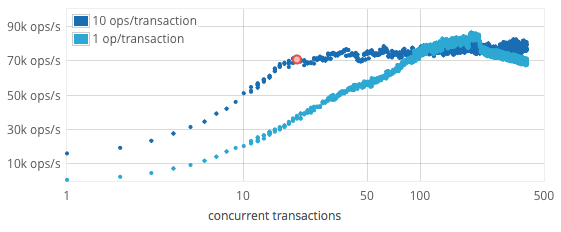| Table of Contents |
|---|
...
| Reference_description_with_linked_URLs________________________________________ | Notes______________________________________________________________ |
|---|---|
Fast-Fabric POC whitepaper | |
Fast-Fabric slide deck | |
https://github.com/IBM/hlf-internals https://github.com/IBM/hlf-internals/blob/master/docs/index.md | Fabric v1.4x architecture internals Christian Vecchiola |
| https://www.meetup.com/es-ES/Hyperledger-Madrid/events/270078655/ | Fabric performance best practices meetup notes |
| https://image.samsungsds.com/us/en/insights/res/__icsFiles/afieldfile/2019/02/ 16/2019.02.15_Blockchain_AcceleratingThroughputinPermissionedBlockchain Networks.pdf?elqTrackId=8f12b155e7b849998e39adbe583b9a66&elqaid=507&elqat=2 | Samsung Accelerator add in for Fabric that may speed transaction throughput up to 10x ( expect 2x ) |
| Performance Use Cases | |
dltledgers automates Air Asia commodity freight transport on Fabric – tested at 2,000 TPS | |
Empirical Performance Analysis of Hyperledger LTS for Small and Medium Enterprises ilnk Enterprisesfabric-performance-v1.2-mdpi.com-Empirical Performance Analysis of Hyperledger LTS for Small and Medium Enterprises.pdf pdf | Fabric LTS 1.2 performance for medium size companies *** |
| https://pdfs.semanticscholar.org/9e51/e5721d0287d5b6e1a2296b7830857f884d7b.pdf | 2018 benchmarking of Fabric on LTS v1.2 Kafka |
| Performance strategies | |
| https://www.consortia.io/blog/scale-your-blockchain-dlt-based-supply-chain/ | |
Performance articles, resources | |
| https://learn.bybit.com/blockchain/fastest-cryptocurrencies-high-tps/ | 2023 comparison on DLT TPS, finalization estimates Polygon (MATIC) is a blockchain that seeks to scale the Ethereum network by supporting multiple scaling solutions, including Layer 2 and sidechain solutions. It boasts a high throughput of 7,000 TPS and a finality time of 2–3 seconds Fabric v2x
Fabric v3x
|
| https://diablobench.github.io/ | Project Diablo compares blockchain performance Diablo is a benchmark suite to evaluate blockchain systems on the same ground. |
Key Concepts
Blockchain Performance Concepts
...
Fast-Fabric performance engineering – 01/30/2019 review
https://arxiv.org/pdf/1901.00910.pdf
What did the Fast-Fabric performance POC do?
...
On average Bitcoin processes about 7 transactions per second, which makes it pretty slow compared to Ethereum (15) and Ripple (the fastest major cryptocurrency, at 1,500 per second). Visa does 24,000 transactions per second. You can how strong Fabric could be with these improvements in a production release and sharding added.
Key Fast Fabric optimization opportunities
We hence design and implement several architectural optimizations based on common system design techniques that together improve the end-to-end transaction throughput by a factor of almost 7, from 3,000 to 20,000 transactions per second, while decreasing block latency. Our specific contributions are as follows:
1) Separating metadata from data: the consensus layer in Fabric receives whole transactions as input, but only the transaction IDs are required to decide the transaction order. We redesign Fabric’s transaction ordering service to work with only the transaction IDs, resulting in greatly increased throughput.
2) Parallelism and caching: some aspects of transaction validation can be parallelized while others can benefit from caching transaction data. We redesign Fabric’s transaction validation service by aggressively caching un-marshaled blocks at the committers and by parallelizing as many validation steps as possible, including endorsement policy validation and syntactic verification.
3) Exploiting the memory hierarchy for fast data access on the critical path: Fabric’s key-value store that maintains world state can be replaced with light-weight in-memory data structures whose lack of durability guarantees can be compensated by the blockchain itself. We redesign Fabric’s data management layer around a light-weight hash table that provides faster access to the data on the critical transaction-validation path, deferring storage of immutable blocks to a write-optimized storage cluster.
4) Resource separation: the peer roles of committer and endorser vie for resources. We introduce an architecture that moves these roles to separate hardware
Samsung Accelerator transaction speed booster for Fabric - some limitations
...
Benchmark per core for 90% read and 10% write - normal work loads
Its asynchronous design allows it to handle very high concurrency, and for a typical workload with 90% reads and 10% writes, maximum throughput is reached at about 200 concurrent operations. This number of operations was achieved with 20 concurrent transactions per FoundationDB process each running 10 operations with 16 byte keys and values between 8 and 100 bytes.
The concurrency graph uses a single FoundationDB server process on a single core (E3-1240).
Potential Value Opportunities
...
